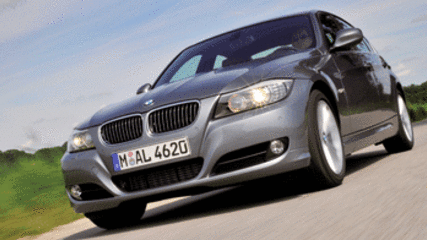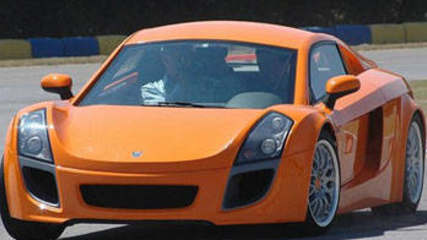HSV Grange 2008 Review
By Brendan Quirk · 21 Jul 2008
You can rant and rave all you like about gas-guzzling V8s and big cars.But you only have to ride in one for a week to realise why those who can afford them love them so much.Take, for instance, Holden Special Vehicle's Grange. Suspension, brakes and engine, along with a few body bits, have been targeted for work that makes the Grange only slightly less plush than a Caprice in the ride department but which turns the Grange into a real wolf in sheep's clothing.On the one hand, you have the plush leather interior, all mod cons, bells and whistles and amazing passenger space and on the other, the HSV 6.2-litre Chev V8 that becomes, if you stick your boot into it and leave the pedal to the metal, a snarling rocket ably backed up by uprated brakes and suspension. If you happen to be taking two persons of the female persuasion to the airport for a long trip with their copious amounts of luggage, don't worry. The Grange boot gobbles up almost anything you can throw at it and even allowing for a long-legged teenager in the front passenger seat, there is still enough room in the back to hold a party. Well, almost.It is not until you get in a car like the Statesman or Grange that you realise just how compact even larger European and Japanese cars really are.The Grange, with luxurious leather seats, DVD screens in the back of the front seat headrests and room to really stretch out, lends itself to back-seat passengers.In fact they can have almost as much fun as the driver.DRIVINGwhile it still has claims as a limo, the Grange is really a driver's car. Treat the throttle gently and it moves along with just the merest hint of a burble from the four exhaust pipes. And keep the suspension on plush rather than sport and you could be in a Caprice.If the red mist descends and the road ahead is winding and empty, the six-speed auto becomes a tiptronic, the magnetic ride control stiffens up the suspension and lots of throttle produces lots of acceleration and noise.While the Grange is not in the sportscar handling category, it does get round corners remarkably well, the big fat tyres hanging on and the stiffened suspension keeping the bulky car, 1.94 tonnes, on track. If you keep the ESP on, and there is no valid reason for turning it off on public roads, there will eventually be a little bit of oversteer before the electronic guardian angel decides enough is enough and pulls the pin on a few cylinders.Those dirty big brakes also come to the party. Given they have to deal with more than two tonnes if there are a couple of people on board, they perform predictably with good progressive pedal feel. Perhaps a race track may stress them more but in normal road work they performed faultlessly.When it comes to getting from corner to corner, 6.2-litres of Chevrolet V8 does the job as well as anything, as you might expect when 317kW (440bhp) is put to work, work that will eventually see it hit 250km/h if you can find a track with a decent straight.Between induction noise and exhaust burble, you know you are making those cubic inches earn their keep. In fact, that V8 symphony is a bit of a tease and the urge to hear it can often overcome the urge to keep a clean licence.The Chevrolet symphony should only be played when those in the car are the only ones listening to it.What about finish and fit?Is it as good as the European efforts? By and large yes. There is precious little noise in the cabin and most of that is from the tyres and varies with the road surface. The biggest indictment of the test car cabin was perhaps that the front passenger's glovebox popped open under some particularly vigorous cornering on a rough surface.That, of course, may well have been due to the fact it was not shut firmly in the first place.GM claims a combined (urban/highway) fuel consumption figure of 15litres/100km.On the open road at a steady cruising speed the big US donk sipped anything between 8-11 litres/100km depending on the surface and gradient and if you booted it around town the figures became little short of frightening.Anyone keen to equal or better the claimed figure would need a light foot and disdain for that delightful Chevrolet symphony.Apart from the HSV go fast bits, the Caprice already comes with almost everything designed to pamper, including: fixed-front seats cup holders and rear seat pop out cup holders, airconditioning with individual climate control for each front occupant and a rear seat climate control, power windows front and back, speed proportional power steering, four-wheel ABS, electronic traction control via ABS and engine management, a 10-speaker Bose stereo system, DVD/VCD with display screens on dash (only when stationary) and backs of front seats, cruise control, trip computer displaying average speed, average fuel consumption, instantaneous fuel consumption and range for remaining fuel, smart key, including central locking, memory seat adjustments and radio settings, just to mention a few.HSV WM GrangePRICE: $84,690ENGINE: 6.2-litre LS3 aluminium alloy 90 degree OHV V8, cross-flow heads, twin knock control sensors compression 10.9:1.103.2 mm bore, 92.0 mm stroke,POWER: 317kW @ 6000rpmTORQUE: 550Nm @ 4600rpmFUEL: PULP, 73 litres 14.5 litres/100km (claimed combined) Using 95RON (PULP) or lower will not cause any problems, but will result in slightly less engine performance and economy.BRAKES: Front: 365mm ventilated discs. Four piston calipers Rear: 350mm ventilated discs. Four piston calipersTRANSMISSION: 6-speed Automatic Transmission with active select Limited Slip Differential with HSV specific ratio Sports Suspension with MRC Electronic Stability Control (ESC), Anti-Lock Braking System (ABS), Electronic Brake force Distribution (EBD), Electronic Brake Assist (EBA), Traction Control System (TCS)WHEELS/TYRES: 19" x 8" front alloy wheel with 245/40 R19 98Y full size spare 19" x 9.5" rear alloy wheel with 275/35 R19 96Y














